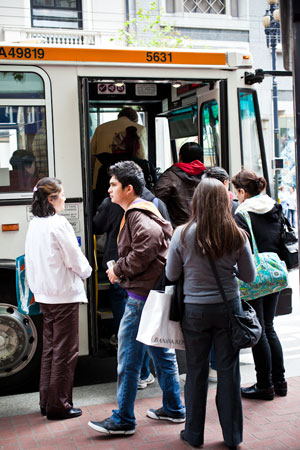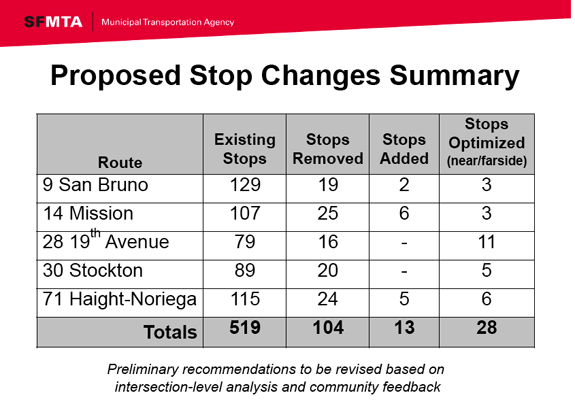
The SFMTA has released a much-anticipated bus stop consolidation plan [pdf] and while it is only in the planning stages and will take a concerted outreach effort to pass, the agency is finally publicly embracing a measure long pushed by transit advocates as an inexpensive way to speed up the system and make it more reliable.
As first reported in the Chronicle this morning, the proposal prepared for the Service Restoration Task Force calls for the elimination of 109 stops along the 9-Bruno, 14-Mission, 28-19th Avenue, 30-Stockton and 71-Haight-Noriega lines.
The walking distance to stops along these high-ridership routes would increase by 10 percent, but a recent Muni survey showed that a majority of passengers (61 percent) would consider walking farther if it improved their overall travel time.
"It's great that the MTA has finally produced a concrete proposal for five important routes. This is MTA's first definite step towards the strategy sketched out in the Transit Effectiveness Project," said Tom Radulovich, the executive director of transit non-profit Livable City.
The plan must still be approved by the SFMTA Board, but in an interview with Streetsblog, Chair Tom Nolan said he believes directors would back it.
"I think we can do it," said Nolan, adding that the board would need to address the views of seniors and people with disabilities. "That's where we have to balance the whole thing, keeping in mind these individual areas and citizens."
Dave Snyder, the project director for the Transit Riders Union, said bus stop consolidation is a great step, but it would need to be combined with other measures to speed up the system.
"Bus stop consolidation is only of many measures that the MTA could take to reduce travel time," said Snyder, who added that the agency needs to seriously consider switching to pre-paid and backdoor boarding, along with converting to low-floor buses.
The proposal does acknowledge that traffic engineering changes "combined with low-cost street design changes" can also reduce travel times. They include adding or extending turn pockets, modifying meters and color curb zones, optimizing signal timing and adding traffic signal actuation.





